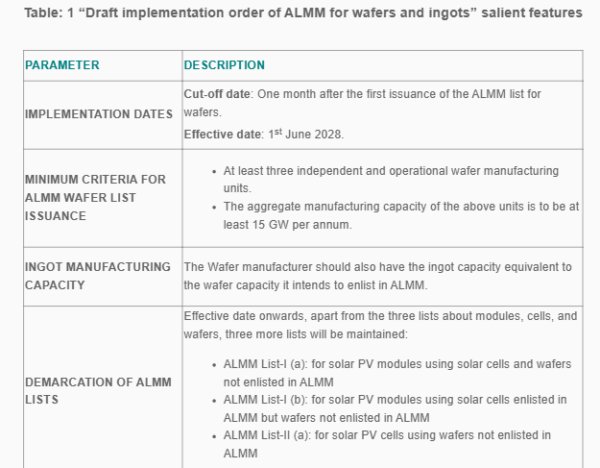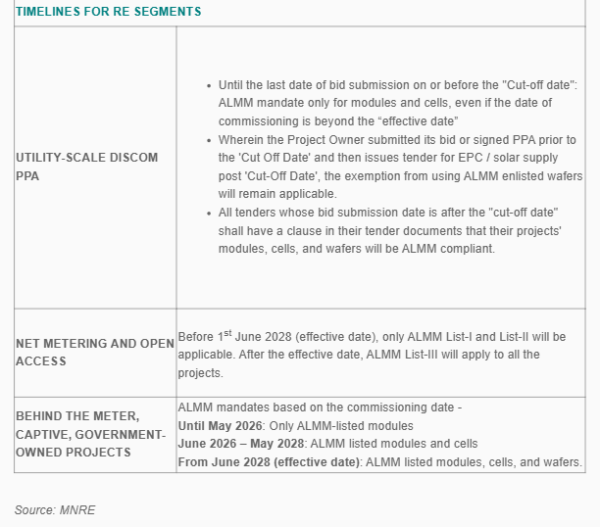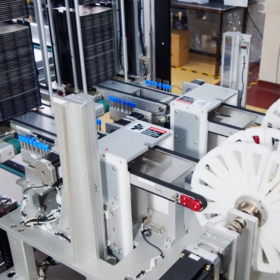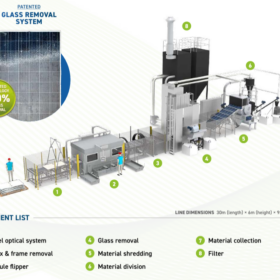Reinforcing the announcement by Shri Prahlad Joshi to target PV upstream integration last week, MNRE has released a draft order for the implementation of the Approved List of Models and Manufacturers (ALMM) for wafers and ingots (ALMM List – III). The order specifies that at least three independent wafer/ingot manufacturing units should be operational in India for ALMM List-III to kick in, with a combined minimum annual capacity of 15 GW. MNRE has set the “effective date” of nationwide implementation of ALMM List-III as 1st June 2028.
Akin to the ALMM for solar cells, MNRE has proposed to issue the ALMM List-III before its “effective date” of implementation. Interestingly, the date of first issuance of ALMM List-III will dictate the “cut-off date” after which bidders can only use ALMM List-III compliant modules in the utility-scale DISCOM PPA tenders. ALMM List-III will also apply to net metering, open access, and behind-the-meter (BTM) projects, albeit with differing implementation timelines shared in the table below.


Some market stakeholders have cited the implementation schedule of ALMM List-III as too stringent, considering it is only two years after the respective implementation date for ALMM List-II. Additionally, clubbing wafers and ingots into a single bucket disregards evolving next-gen efficient PV technologies wherein wafers are produced without producing a similar capacity of ingots. Furthermore, stakeholders have expressed that the 15 GW annual threshold for wafers is insufficient to support the anticipated production capacities for cells (over 100 GW) and modules (up to 180 GW) in India by 2028.
Despite these criticisms, the draft implementation clearly indicates the government’s commitment to advancing domestic PV upstream integration and bridging the capacity gap between modules, cells, and wafers. Issuing this order nearly three years before its effective date and one year before the implementation of ALMM List-II will allow solar manufacturers to plan for wafer capacity alongside their upcoming cell capacities. Moreover, the fact that wafer and ingot manufacturing is less capital-intensive and technologically complex compared to cell manufacturing may further encourage this trend. In the future, the government might also develop a similar list for polysilicon, aiming to localize the entire solar PV value chain within India.
India’s PV manufacturing industry is at a pivotal moment in its journey. As India scales its manufacturing capabilities across the PV value chain to achieve self-sufficiency and be a viable alternative to China in global markets, furnishing equivalent impetus to the quality of PV products is paramount. Therefore, the government should support capacity expansion through initiatives that promote research and development (R&D) and the strengthening of technical capabilities. Ensuring an optimal balance between establishing a robust domestic PV supply chain and meeting future project development goals will be essential for shaping India’s journey toward achieving Net Zero emissions.
The views and opinions expressed in this article are the author’s own, and do not necessarily reflect those held by pv magazine.
This content is protected by copyright and may not be reused. If you want to cooperate with us and would like to reuse some of our content, please contact: editors@pv-magazine.com.








By submitting this form you agree to pv magazine using your data for the purposes of publishing your comment.
Your personal data will only be disclosed or otherwise transmitted to third parties for the purposes of spam filtering or if this is necessary for technical maintenance of the website. Any other transfer to third parties will not take place unless this is justified on the basis of applicable data protection regulations or if pv magazine is legally obliged to do so.
You may revoke this consent at any time with effect for the future, in which case your personal data will be deleted immediately. Otherwise, your data will be deleted if pv magazine has processed your request or the purpose of data storage is fulfilled.
Further information on data privacy can be found in our Data Protection Policy.